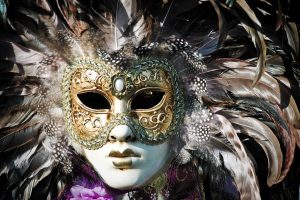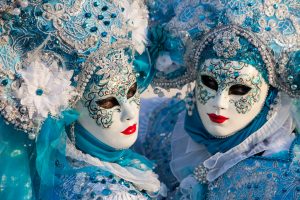 We often associate carnivals with masks. In fact it is impossible to separate those fancy masks from the Carnevale or Mardi Gras celebrations today. But when and how did this tradition even begin?
We often associate carnivals with masks. In fact it is impossible to separate those fancy masks from the Carnevale or Mardi Gras celebrations today. But when and how did this tradition even begin?
The earliest of these masquerade festivals is known to be Carneval di Venezia, which dates back to 13th century. It is believed that the tradition of wearing the mask started as a tool to conceal their identity when Venetians would hold celebrations before Lent started. These celebrations were the only times when the upper and lower classes would socialize together. Hidden behind their masks, both aristocrats and peasants would engage in illegal activities such as gambling or underground affairs (as well as partying and dancing!). After all, the city was relatively small and not everyone wanted to share their personal life with others… The Venetian masks therefore at first symbolized freedom and class equality, allowing all citizens to indulge in behaviors that were otherwise seen as inappropriate.
As Venetians started wearing the masks in their daily lives besides the celebrations, illicit activities started to become very popular and sexual promiscuity b ecame publicly acceptable. Eventually, the Republic limited the wearing of masks to only certain months of the year, which included the Carnevale period. The tradition quickly spread out across the world and today masks have become iconic symbols of festivals. Whether you’re celebrating Mardi Gras, Carneval di Venezia or Brazilian Carnival, you will be surrounded by glamorous masks full of long feathers, elegant hats and lavish patterns.
ecame publicly acceptable. Eventually, the Republic limited the wearing of masks to only certain months of the year, which included the Carnevale period. The tradition quickly spread out across the world and today masks have become iconic symbols of festivals. Whether you’re celebrating Mardi Gras, Carneval di Venezia or Brazilian Carnival, you will be surrounded by glamorous masks full of long feathers, elegant hats and lavish patterns.
Now that you learned all about the history of carnival masks, grab one for yourself and celebrate this exciting festival with us at Via Umbria!
For more information on our carnival events, please visit viaumbria.com/events


About The Author